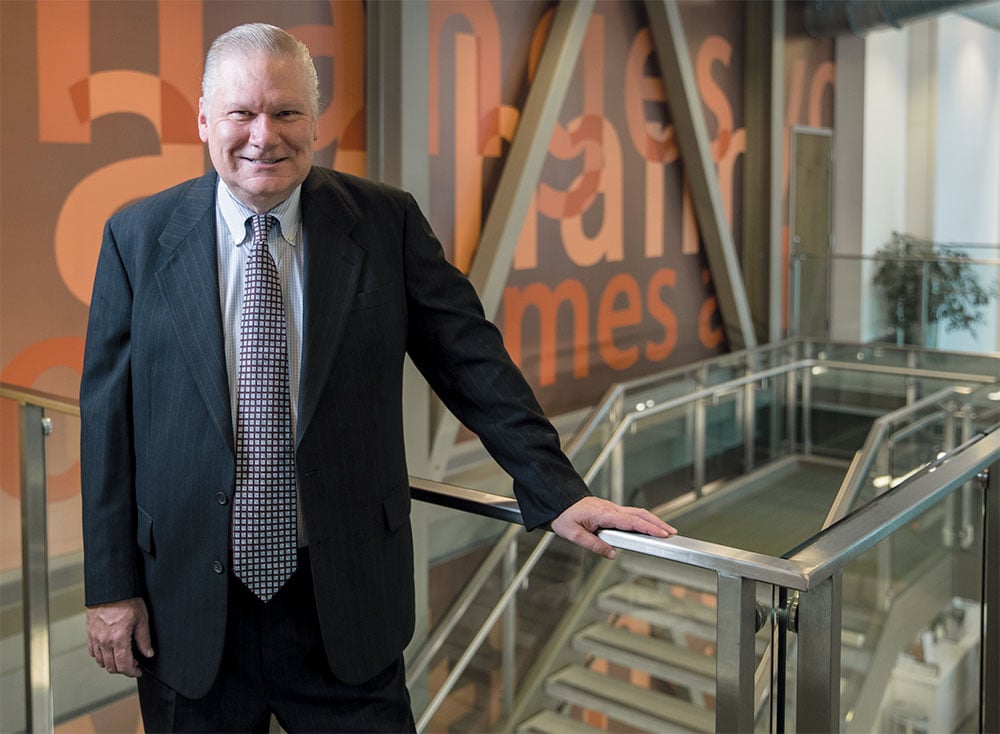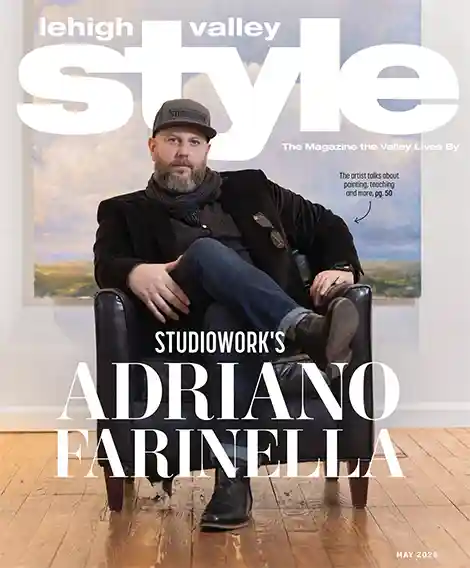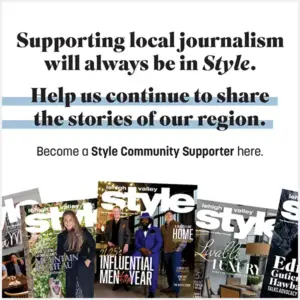This past summer, thousands of children and parents gathered at PBS39 over the course of 10 weeks, celebrating the summer and having fun learning. It was the type of public community event that the station is striving to be known for—and a perfect example of how WLVT is extending its service far beyond broadcasting.
PBS39's summer program at 839 Sesame Street at the SteelStacks campus in Bethlehem was nearly 50 years in the making. They moved to their new site seven years ago, after spending 44 years at the Mountaintop Campus of Lehigh University. The public broadcasting station went on the air in 1967, primarily dedicated to children's programming and classroom-related topics. The station then spent the next three decades producing a growing number of local interest programs, remote broadcast sports and other events, and news broadcasts.
But something was missing. While the station was getting high-quality programs to viewers, they were limited in the way viewers could actively interact with PBS39.
“The old facility wasn't in a great spot. It was in a rural area, and it wasn't a friendly space with a lot of community space,” says CEO Tim Fallon. “In the height of the recession, we took a great leap of faith and developed the PPL Public Media Center at the SteelStacks center.”
The station called the move “WLVT 2.0.”
“With the new space, it was designed to have as many people as possible here. We immediately began having events in our community room, welcoming the community into our space as often as we could,” he says. The station began engaging the local community and schools more frequently, increased the production of local documentaries and earned a series of awards from their new and more robust programming—all while working with a loss of $1 million in funding from the state.
Several years after moving to Bethlehem, PBS39 received a substantial windfall through the FCC's spectrum auction. WLVT agreed to share a broadcasting channel with another station, then auctioned off their own channel to be used for wireless communication broadband—receiving millions of dollars to fund their newest initiatives and reinvent themselves yet again as “WLVT 3.0.” This money was also used to create an endowment of sorts, which now covers 60 percent of the company's operating budget each year.
What does this mean for viewers? How PBS39 shows up on television hasn't changed, but viewers will receive a broader array of programming and community programs. The auction funds also mean that every dollar donated to PBS39 by viewers goes directly to finance programs provided to the community.
Moving the Needle
One thing that has remained consistent with PBS39 is their desire to improve the local community—and that's truer than ever with WLVT's newest strategic plan.
“‘WLVT 3.0' is about asking how PBS39, as a public media entity, can make the most impact on our community for the most people. We don't want to do things that are light touch. We want to move the needle and make this a better community for all of us,” says Fallon. “What makes us unique is that we have the megaphone of being a broadcast television station,” and the legacy of the PBS brand, to help them reach their goals and become a powerful advocate for the community's needs.
Lehigh Valley Reads is one example of this. It's a collective impact program being led by United Way to break the cycle of poverty within a generation, by ensuring that all children in the Lehigh Valley are reading at a third-grade level by third grade. Third-grade reading abilities are a strong indicator of future success and poverty levels, says Fallon.
One of United Way's focuses is the educational decline that children experience during summer break. But United Way and PBS39 are going far beyond summer reading programs—they are working with other agencies to identify and fill the gaps that occur from birth to third grade that lead to low literacy rates. These gaps might include parents who cannot read, limited access to children's books and a lack of high-quality, affordable pre-k programs.
“We want to surround these children with multiple opportunities, from the time they are born to before school, after school and throughout the summer to ensure that they are reading at grade level by third grade,” says Fallon. “If we can do that, we are going to make a real impact on the poverty level in the Lehigh Valley. We are dedicating significant human and capital resources to this. This is a game changer.”
PBS39's goal with Lehigh Valley Reads is to gather data to prove that the program is working, use this data to lead a fundraising effort among regional and national funders and get the word out to families in the community who can benefit from this program.
“We need to let them know what we're doing. It doesn't do a caregiver any good if they don't know that there is a program that their child can get involved in that will help with literacy,” says Fallon. “This is something that I am very passionate about. This has nothing to do with broadcast television, and everything to do with making a difference in the community.”
Another major initiative driven by PBS39 this year is their fight against the opioid crisis. During National Recovery Month in September, all seven public broadcasting stations in Pennsylvania simultaneously aired a “community conversation” program, which included vignettes from each station. The program concluded with a 30-minute call-in section. Callers could be transferred directly to a crisis center, or request resources and guidance on how to help a family member in crisis. PBS39 also launched battlingopioids.org to do additional on-air programs in the winter and spring. “This is based on something the Maryland stations did last year. They impacted tens of thousands of people with this particular show in Maryland, and we're hoping to do the same,” he says.

Education
The national PBS brand has long established itself as a champion of education. Locally, PBS39 has produced Scholastic Scrimmage annually for 44 years. PBS39 also offers the Raising Readers program, which promotes interactions between children and caregivers at local elementary schools.
This past summer was their first PBS Summer Kids series, in which more than 3,200 children and their parents visited the studio over 10 weeks to attend programs in arts and crafts, music, yoga, story time and more.
“While these programs are fun and entertaining, they are educationally based. The key is to build learning into fun,” Fallon says. “Being here in the south side of Bethlehem, within walking distance of a lot of folks and on the bus routes, we are also accessible to a lot of folks that don't necessarily have access to other programs.”
Older children can take part in programs like PBS39 Artist of the Month, which highlights young artists on their channel and website. PBS39 also hosts Production U each summer, inviting high school students into the studio to learn about modern media.
Teachers have access to PBS Learning Media, a free digital resource that provides teachers with lesson plans, videos and printable materials on age-appropriate lessons that can supplement or expand existing curriculum.
“It's all right there, and it's free of charge. It's vetted, approved curriculum that is accessible to all of the 31 school districts in our area,” he says.
‘Viewers like you'
PBS39 is renewing its dedication to serving its entire broadcasting area, which includes Lehigh and Northampton counties and the eight counties they touch: Carbon, Monroe, Schuylkill, Bucks, Montgomery and Berks counties in Pennsylvania, and Warren and Hunterdon counties in New Jersey.
They recently launched a nightly news broadcast, the first to air on their channel since the 1990s, and have embedded 10 reporters in the 10 counties that they serve.
“You won't see any sports or weather in our broadcast. If there's a big snow storm, what our story will be is the fact that when schools are closed, a lot of kids go hungry because sometimes the only full meal they get is at school. Those are the types of stories that we try to do,” he says. “There are about 3.2 million people in the 10 counties we serve. There is a plethora of stories and diversity in our area.”
Because PBS is not driven by advertising revenue, they have more flexibility to cover community stories and offer a wide variety of programming.
Their Spanish language program, Es Tiempo, is their first Spanish program in more than 20 years. The weekly talk show debuted in September and highlights the Latino community in the Greater Lehigh Valley.
PBS39 also uses its public media podium to host election debates and Election Day coverage, and Town Halls, which cover a wide variety of topics that impact our area.
“Most recently, we did a Town Hall to discuss the impact of Hurricane Maria in Puerto Rico on the Lehigh Valley,” says Fallon. They've also done a Town Hall with the new mayor of Allentown, and a session on juvenile mental health issues.
“It's not the most exciting topic if you're trying to sell advertising around it, but we're not. We're trying to provide a community service. It was a powerful event,” he says. “These are the things that public media bring to the table.”
















